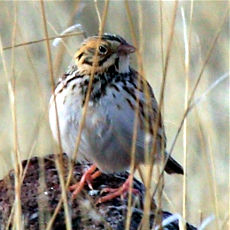THE MIXED-GRASS PRAIRIE
A vast expanse of grassland once stretched across the Canadian
prairie provinces. Short-grass prairie, the most drought tolerant,
was found in the rain shadow of the Rockies. In the moisture rich
Red River Valley of Manitoba, a lush carpet of grasses and wildflowers
grew in the tall-grass prairie. Mixed-grass prairie lay between
the two prairie types, blending elements of both short-grass and
tall-grass prairie. Here, the wildflowers and grasses grew to
knee height and huge herds of bison roamed the plains. |

Range of the mixed-grass prairie. |
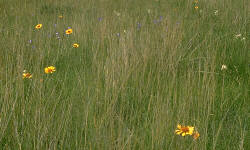 The
beauty and resilience of the mixed-grass prairie lies in its incredible
diversity of species. There are over 150 species of plants, each adapted
in its own way to the extremes of temperature, variation in precipitation
and the effects of fire and grazing animals. Local topography, the nature
of the soil, and year-to-year changes in moisture and temperature help
determine the mix of plants found in a particular prairie. In areas with
well drained soils, drought tolerant grasses such as western wheatgrass
and blue grama may grow, but within metres, little bluestem, a grass requiring
more moisture, will dominate. The
beauty and resilience of the mixed-grass prairie lies in its incredible
diversity of species. There are over 150 species of plants, each adapted
in its own way to the extremes of temperature, variation in precipitation
and the effects of fire and grazing animals. Local topography, the nature
of the soil, and year-to-year changes in moisture and temperature help
determine the mix of plants found in a particular prairie. In areas with
well drained soils, drought tolerant grasses such as western wheatgrass
and blue grama may grow, but within metres, little bluestem, a grass requiring
more moisture, will dominate.
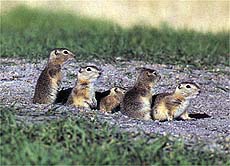 All
animals, from voles and ground squirrels to large grazers like bison
play a role in the development and composition of a prairie. Any disturbed
ground - along an animal trail, beside a burrow or in a bison wallow
- can encourage plants that complete their life cycles in one season,
to sprout, holding the soil until the longer living grasses and wildflowers
establish themselves. All
animals, from voles and ground squirrels to large grazers like bison
play a role in the development and composition of a prairie. Any disturbed
ground - along an animal trail, beside a burrow or in a bison wallow
- can encourage plants that complete their life cycles in one season,
to sprout, holding the soil until the longer living grasses and wildflowers
establish themselves.
Numerous combinations of moisture, topography, soil and disturbance
exist making every prairie unique and dynamic in its species and appearance.
In Manitoba, mixed-grass prairie occurs in areas receiving between 25
cm and 50 cm (10"-20") of precipitation annually. Its occurrence is
also determined by the presence of soils that are sandy or well-drained.
Remnants of mixed-grass prairies are often found inter-mingled with
aspen stands and other grassland communities.
Mixed-grass prairie and many of its plants and animals have been and
continue to be lost. As early as the 1860's, settlers were having dramatic
long term effects on the prairies. By the 1880's plains bison, plains
wolves and passenger pigeons had been eliminated and many other plants
and animals were diminishing rapidly. The prairie itself was being lost
as homesteaders broke the sod to grow crops. The introduction of exotic
or weed species, such as leafy spurge and Canada thistle, and the invasion
of native shrubs and trees, led to the degradation of thousands of hectares
more. It is estimated that there were originally 24 million hectares
of mixed-grass prairie in Canada. Today it covers less than one quarter
of that area.
PLANTS OF THE MIXED-GRASS PRAIRIE
Prairie plants are perfectly adapted to their environment. Many have
extensive roots systems that are ideal for absorbing moisture and nutrients
from the soil during periods of low moisture. These root reserves are
important for regrowth after grazing or burning. Some plants, cool-season
plants, begin their growth early in the season to take advantage of
the early spring moisture and stop growth in the heat of the summer.
Other plants called warm-season plants have adapted to the hot summers
and low moisture levels by changing the way they produce food in their
leaves and stems. Their unique metabolism allows them to grow during
hot, dry weather without losing precious moisture.
At first glance, mixed-grass prairie may simply look like a field of
unmown grass, but a closer look reveals the complexities and subtle
enchantment of this prairie world. Some of the typical wildflowers and
grasses you may find when you visit mixed-grass prairie are illustrated
here.
Spear grass
(Stipa comata)
The slender pointed fruits of spear grass have long twisted "beards"
or awns projecting from their tips. After the seed is shed, the
first moisture causes the awn to straighten. Then, in drying out,
it twists again and screws the seed into the soil, where it can
germinate. These "spears" are often found embedded in the pant
legs and shoe laces of visitors. |

|

|
Indian breadroot
(Psoralea esculenta)
Indian breadroot has a thick tuberous root, once valued as a
food source by Aboriginals and early settlers. This plant is very
sensitive to disturbance; the presence of Indian breadroot usually
indicates a healthy prairie. |
Purple prairie clover
(Petalostemon purpureus)
Both purple prairie clover and a close relative, white prairie
clover, are important in prairie communities. These plants are
members of the pea family which fix nitrogen and make it available
to other plants. The small flowers begin as a circle around the
head and work upward as the season advances. |

|

|
Prairie crocus
(Anemone patens)
A sign of spring in North American prairies and Manitoba's floral
emblem, the crocus often blooms shortly after the snow disappears.
Its many-divided, silky leaves arise after flowering is completed.
|
Dotted blazing star
(Liatris punctata)
Blazing star and its close relatives were once used by Native
Americans to treat kidney diseases and have long been cultivated
in European gardens as bedding plants and for cut flowers.
|

|

|
June grass
(Koeleria gracilis)
Common throughout mixed-grass prairies, this grass begins its
growth in early spring. By July, growth of this cool season plant
is completed and the grass goes dormant until fall or the following
spring. It is commonly found along trails in mixed-grass prairie.
|
Blue grama
(Bouteloua gracilis)
Blue grama is easily recognized by its seed head that resembles
a toothbrush. This warm season grass is very drought hardy and
will out compete taller grasses in times of low moisture. |

|

|
Little bluestem
(Schizachyrium scoparium)
This vigorous, long-lived warm season species is found throughout
mixed-grass prairies in Canada and the United States. It is highly
palatable and nutritious for livestock and wildlife. In autumn,
little bluestem turns the prairies a beautiful reddish purple.
|
Purple coneflower
(Echinacea angustifolia)
The prickly centre of the purple coneflower gives this plant
its scientific name - Echinacea - from the Greek word meaning
hedgehog or sea-urchin. The root was used by Aboriginals as a
painkiller for toothaches and sore throats. |

|
THREATENED AND ENDANGERED SPECIES IN MIXED-GRASS
PRAIRIE
Manitoba's Endangered Species Act (1990) protects plant and animal species
that are considered endangered or threatened within Manitoba. Under the
Act, native species threatened with extinction are classified as "endangered".
Native species likely to become endangered or found in low numbers are
classified as "threatened". A species is considered "vulnerable" if it
is found in low numbers or restricted areas but is not yet threatened.
Vulnerable species are not protected under the Act. The following mixed-grass
prairie species are recognized and protected as endangered or threatened
in Manitoba.
Small white lady's slipper (Cypripedium candidum)
The small white lady's slipper is an endangered orchid found
in wet meadows in fewer than 10 locations in southern Manitoba.
It grows in clumps, blooming briefly in late May or early June.
Like many orchids, the small white lady's slipper cannot reproduce
without the presence of a companion fungus, nor can the mature
plants live without a symbiotic fungus found within its root system.
It is unlawful to pick, dig or disturb the surroundings of this
plant. |

|

|
Burrowing Owl
(Athene cunicularia)
The Burrowing Owl prefers grazed pastures or mixed grass prairie.
Unlike any other North American owl, it nests below ground, occupying
abandoned ground-squirrel burrows. Once common to the grasslands
of western Canada, the Burrowing Owl can no longer be found in
large portions of its historic range. In Manitoba, the known nesting
population had dwindled to four pairs by 1995. The loss of nesting
habitat and the poisoning of owls by insecticides intended to
control grasshoppers have contributed to their decline. |
Ferruginous Hawk
(Buteo regalis)
The largest North American hawk, the Ferruginous Hawk is often
seen soaring above the open grasslands searching for ground-squirrels.
Ferruginous hawks usually nest in isolated trees, building large
flat nests. A breeding pair of Ferruginous Hawks and their young
will eat almost 500 ground-squirrels during a nesting season.
After a suspected absence of some 50 years, Ferruginous Hawks
were found nesting in southwestern Manitoba in 1982. Since then,
the nesting population has grown to about 50 pairs. |

|

|
Loggerhead Shrike
(Lanius ludovicanus)
The Loggerhead Shrike lives primarily in open shrubby country
and dry upland prairie. The shrike is known for its practice of
impaling its food (grasshoppers, insects or rodents) on thorns
and barbed wire. Loss of grasslands and shrub lands, combined
with the accumulation of pesticides in the food chain are the
main reasons for their decline. |
Baird's Sparrow
(Ammodramus bairdii)
The Baird's Sparrow is well camouflaged to blend into its prairie
environment. It can be difficult to find, but its call, two to
three zips followed by a musical trill, is distinctive. It nests
on the ground in idle or lightly grazed native mixed-grass prairie.
Formerly common throughout southern Manitoba, they are now restricted
to the southwest corner of the province.
|
|
MANAGEMENT
The natural forces of fire and grazing helped shape and form mixed-grass
prairie. The extensive root reserves of native plants allow them to
regrow quickly after grazing or burning occurs. In order to maintain
good quality native mixed-grass prairie, rotational grazing and occasional
controlled burning must continue to be used. Excessive grazing can eliminate
or suppress many species. However, the absence of grazing can increase
woody growth and lead to a build up of plant litter, choking out some
native species. Haying or mowing can also decrease woody species when
burning or grazing are not possible.
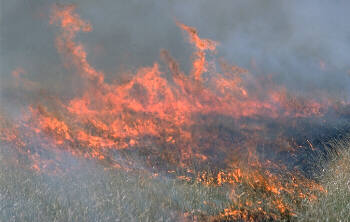
How often a prairie should be burned depends on the purpose of the
burn and local moisture conditions. Properly timed burns can help decrease
woody growth and the presence of weedy species. Annual burns on mixed-grass
prairie can be destructive over the long term, lowering moisture levels
and destroying organic matter in the soil. Each prairie should be treated
individually, according to the plant species present and the surrounding
land use.
WHY SAVE IT?
The reasons to save native mixed-grass prairies are many and varied.
It is home to wide variety of plants and animals, some that are commonplace
and others that are rare. Species like sharp-tailed grouse and deer
are frequently observed but some, such as the small white lady's slipper
and burrowing owl, are seen only by a lucky few. Native prairies and
the species in them are often useful, economically and scientifically.
No one knows what value prairie species may hold for future crops, medicines
and other products. Native mixed-grass prairie is a living museum brimming
with beauty and untapped information, a rich natural heritage for all
Manitobans.
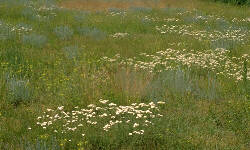
NatureNorth.com would like to thank the Critical Wildlife Habitat Program and the Wildlife Branch, Manitoba Natural Resources for permission to reproduce this "Manitoba's Mixed Grass Prairie" brochure.
For more information please
contact:
Critical Wildlife Habitat
Program
Box 24 200 Saulteaux Cres.
Winnipeg, Manitoba
CANADA
R3J 3W3
(204) 945-7775
Thanks for learning about Manitoba's Mixed-grass Prairie! Bye for now! |




 The
beauty and resilience of the mixed-grass prairie lies in its incredible
diversity of species. There are over 150 species of plants, each adapted
in its own way to the extremes of temperature, variation in precipitation
and the effects of fire and grazing animals. Local topography, the nature
of the soil, and year-to-year changes in moisture and temperature help
determine the mix of plants found in a particular prairie. In areas with
well drained soils, drought tolerant grasses such as western wheatgrass
and blue grama may grow, but within metres, little bluestem, a grass requiring
more moisture, will dominate.
The
beauty and resilience of the mixed-grass prairie lies in its incredible
diversity of species. There are over 150 species of plants, each adapted
in its own way to the extremes of temperature, variation in precipitation
and the effects of fire and grazing animals. Local topography, the nature
of the soil, and year-to-year changes in moisture and temperature help
determine the mix of plants found in a particular prairie. In areas with
well drained soils, drought tolerant grasses such as western wheatgrass
and blue grama may grow, but within metres, little bluestem, a grass requiring
more moisture, will dominate.






